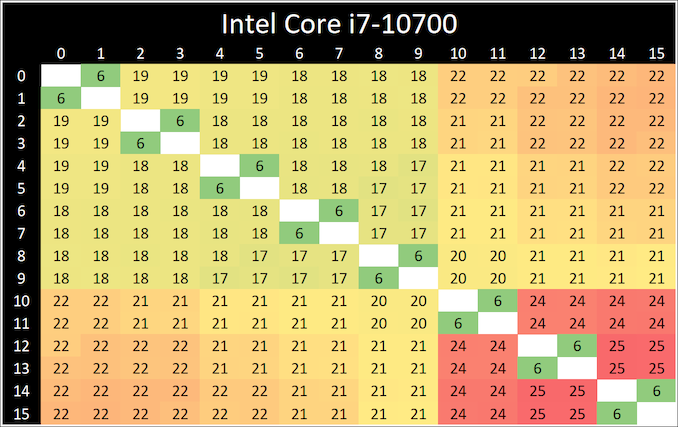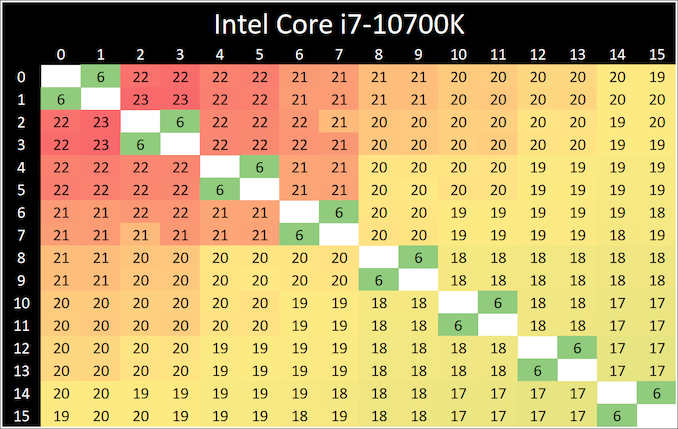Intel Core i7-10700 vs Core i7-10700K Review: Is 65W Comet Lake an Option?
by Dr. Ian Cutress on January 21, 2021 10:30 AM EST- Posted in
- CPUs
- Intel
- Core i7
- Z490
- 10th Gen Core
- Comet Lake
- i7-10700K
- i7-10700
CPU Tests: Microbenchmarks
Core-to-Core Latency
As the core count of modern CPUs is growing, we are reaching a time when the time to access each core from a different core is no longer a constant. Even before the advent of heterogeneous SoC designs, processors built on large rings or meshes can have different latencies to access the nearest core compared to the furthest core. This rings true especially in multi-socket server environments.
But modern CPUs, even desktop and consumer CPUs, can have variable access latency to get to another core. For example, in the first generation Threadripper CPUs, we had four chips on the package, each with 8 threads, and each with a different core-to-core latency depending on if it was on-die or off-die. This gets more complex with products like Lakefield, which has two different communication buses depending on which core is talking to which.
If you are a regular reader of AnandTech’s CPU reviews, you will recognize our Core-to-Core latency test. It’s a great way to show exactly how groups of cores are laid out on the silicon. This is a custom in-house test built by Andrei, and we know there are competing tests out there, but we feel ours is the most accurate to how quick an access between two cores can happen.
When we first reviewed the 10-core Comet Lake processors, we noticed that a core (or two) seemed to take slightly longer to ping/pong than the others. These two parts are both derived from the 10-core silicon but with two cores disabled, and we still see a pattern of some cores having additional latency. The ring on the 8-core parts still acts like a 10-core ring, but it all depends on which cores were disabled.
Frequency Ramping
Both AMD and Intel over the past few years have introduced features to their processors that speed up the time from when a CPU moves from idle into a high powered state. The effect of this means that users can get peak performance quicker, but the biggest knock-on effect for this is with battery life in mobile devices, especially if a system can turbo up quick and turbo down quick, ensuring that it stays in the lowest and most efficient power state for as long as possible.
Intel’s technology is called SpeedShift, although SpeedShift was not enabled until Skylake.
One of the issues though with this technology is that sometimes the adjustments in frequency can be so fast, software cannot detect them. If the frequency is changing on the order of microseconds, but your software is only probing frequency in milliseconds (or seconds), then quick changes will be missed. Not only that, as an observer probing the frequency, you could be affecting the actual turbo performance. When the CPU is changing frequency, it essentially has to pause all compute while it aligns the frequency rate of the whole core.
We wrote an extensive review analysis piece on this, called ‘Reaching for Turbo: Aligning Perception with AMD’s Frequency Metrics’, due to an issue where users were not observing the peak turbo speeds for AMD’s processors.
We got around the issue by making the frequency probing the workload causing the turbo. The software is able to detect frequency adjustments on a microsecond scale, so we can see how well a system can get to those boost frequencies. Our Frequency Ramp tool has already been in use in a number of reviews.
Both processors ramp from idle to full turbo in about six milliseconds, well within a single frame of standard gaming.













210 Comments
View All Comments
Oxford Guy - Monday, January 25, 2021 - link
'What if I don't agree about the location of the "sweet spot" based on RAM prices local to me, or my own performance needs?'Price vs. performance is a different topic. Nice attempt to change the subject, though.
Spunjji - Wednesday, January 27, 2021 - link
It's not at all an attempt to change the subject. The point is that the issue of an "optimal" RAM speed is a moving target dependent on multiple variables.Makste - Saturday, January 23, 2021 - link
As a part of his audience, I am actually satisfied with this review, as I am looking for the out of the box experience. I'm most likely not to tamper with the manufacturer's recommendations. So he tested the CPUs following both Intel and AMD recommendations. Something I don't see a problem with.Oxford Guy - Sunday, January 24, 2021 - link
Turning on XMP is hardly tampering, particularly since motherboard vendors provide lists of recommended RAM to use those XMP profiles with.theqnology - Monday, January 25, 2021 - link
If it shouldn't be the case, shouldn't consumers take it up with Intel, and not with the reviewer? Why does Intel put lower max than the current JEDEC standards (e.g., Intel at 2933 while AMD at 3200)? I ask, if Intel was so confident about their products, why not up the official support?This is really the crux of it. Intel wants to make it part of the difference between their Z boards and their non-Z boards, which adds more cost for the consumers, while at the same time washing themselves from this responsibility should something not work (you cannot RMA based on non-JEDEC compatibility). It is also fascinating that consumers think this is on the reviewers.
Oxford Guy - Monday, January 25, 2021 - link
Sure, as long as the reviewer is consistent with the logic.That means no reviewing boards that violate the official base clock and turbo behavior.
Things like that.
Spunjji - Wednesday, January 27, 2021 - link
Then he can't review any board at all.Honestly, this "everything must be treated exactly the same otherwise nothing is fair" rhetoric is ghastly and corrosive in whatever domain it's applied.
Qasar - Thursday, January 28, 2021 - link
" That means no reviewing boards that violate the official base clock and turbo behavior. "considering that intel doesnt make board makers conform to anything as far as what " default " would be, good luck with this.
quiq - Sunday, January 24, 2021 - link
i want to view the 1070 whit stock box and a h410/470 motherboard thats the real user for a non k cpuvs 10700k and z490 aftermarket HeatSink or WC Oc memories etc Real entusiast cpu
IanCutress - Saturday, January 23, 2021 - link
Please go ahead and enforce both Intel and AMD to rate their memory controllers faster then. Its not opinion, it's the literal standard,and the only way to ensure consistency for comparisons across generations. I'm not going to offer one CPU a higher dram overclock than another, that isn't fair, just in the same way I'm not going to overclocked the cores. I regularly dive into AT's audience metrics, and have done for years. If you want data that's different, then please by all means either do your own testing or find other reviews. But you know, also get them to deep dive into microarchitecture as well as get all the behind the curtain info. Also, all our content is free at the point of use. By your logic, I'm also a consumer of content at AT, thus I also pay my salary. Please enjoy.